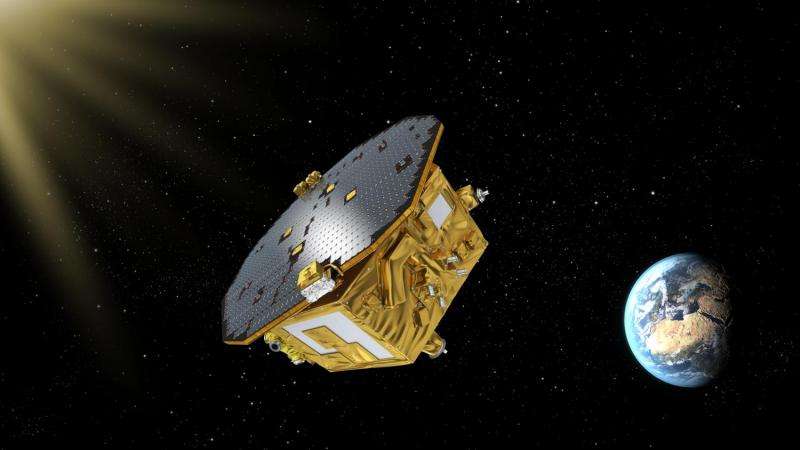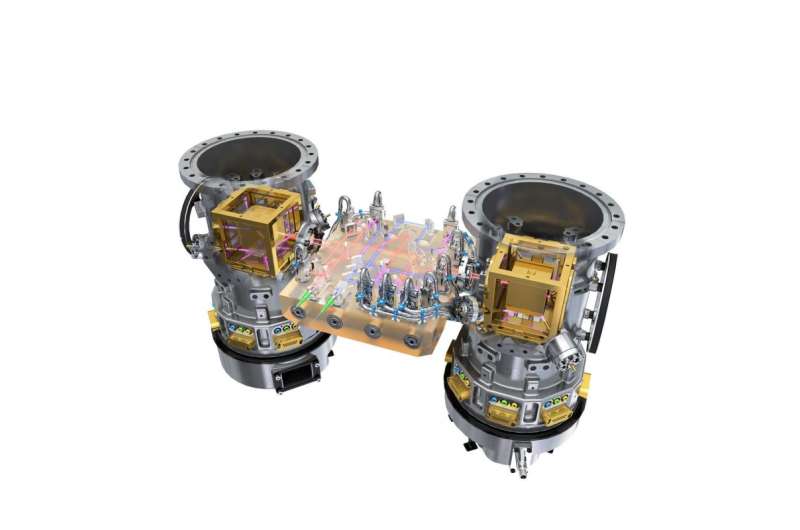A perfectly still laboratory in space

Following a long series of tests, ESA's LISA Pathfinder has started its science mission to prove key technologies and techniques needed to observe gravitational waves from space.
Predicted by Albert Einstein a century ago, gravitational waves are fluctuations in the fabric of spacetime produced by exotic astronomical events such as supernova explosions or the merging of two black holes.
Recently, the first direct detection of these waves inaugurated the era of gravitational astronomy.
A future observatory in space, sensitive to gravitational waves with longer wavelengths than those detected on the ground, would be an essential tool to exploit this new field of study by probing some of the most massive and powerful objects in the Universe.
With LISA Pathfinder, scientists and engineers are testing the technology needed to extend the quest for gravitational waves to space.
In particular, LISA Pathfinder is designed to achieve the purest-known 'freefall', the extremely challenging condition necessary to build such an observatory. To do so, the team released two test masses – a pair of identical 2 kg gold–platinum cubes measuring 46 mm – inside the spacecraft and is now verifying that they are truly moving under the effect of gravity alone.
This is by no means trivial: even in space, there are forces capable of disturbing the cubes, including the radiation and wind from the Sun, and they need be isolated from all of these non-gravitational influences. To do so, LISA Pathfinder continually measures their positions and manoeuvres around them with microthrusters to avoid ever touching them.
"As they fall freely through space, the two test masses should be extraordinarily still, since no other force is perturbing their gravitational motion – only a gravitational wave could jiggle them around," explains Stefano Vitale of University of Trento and INFN, Italy, Principal Investigator of the LISA Technology Package, the mission's core payload.
LISA Pathfinder, however, is not capable of detecting gravitational waves itself. For this crucial technology demonstration, the two freefalling cubes are only 38 cm apart – too close to record the minute wobbles in the fabric of spacetime.
The variation in distance caused by a passing gravitational wave is so small that a full-scale space observatory will need test masses separated by roughly a million kilometres, and be able to detect changes in that separation of about one millionth of a millionth of a metre.
"The precision we need to attain for future observations of gravitational waves from space is so high that it demands an unprecedented understanding of the physical forces at play on the test masses," says Paul McNamara, ESA's Project Scientist.
This is the essence of the LISA Pathfinder mission: after having released the cubes from their locking mechanisms and having made sure they are in the most precise freefall ever obtained, the scientists will now spend the next six months running experiments, 'poking' the masses to verify how still they really are.

To interfere with their motion, the team will apply a number of different forces to them and study their reaction. One experiment will raise the temperature inside the high vacuum environment of their housing, heating the very few gas molecules that are left there, to measure if this has any effect on the cubes.
Increasingly stronger magnetic and electric forces will also be applied to assess what amount of force is needed to divert them from freefall.
"Our aim is not only to reduce the impact of forces that we already know are disturbing the cubes, but also to learn more about the remaining effects that are hidden in the noise," says Karsten Danzmann, director at the Max Planck Institute for Gravitational Physics, director of the Institute for Gravitational Physics of Leibniz Universität Hannover, Germany, and Co-Principal Investigator of the LISA Technology Package.
The scientific mission of LISA Pathfinder officially started on 1 March. Following a formal review of the commissioning period on 7 March, the mission was formally handed over from the ESA project and industrial teams that built it to the scientists who are now busy carrying out experiments on this unique gravity laboratory in space.
These operations will take six months, split between 90 days for the LISA Technology Package and 90 days for the Disturbance Reduction System (DRS), an additional experiment including two extra sets of thrusters, provided by NASA's Jet Propulsion Laboratory (JPL).
"We are looking forward to demonstrating this thruster system and its ability to keep the two test masses extremely still," says Charles Dunn, project technologist for the DRS at JPL.
The results of LISA Pathfinder's precision experiments will pave the way towards the L3 mission in ESA's Cosmic Vision programme, a future project that will be dedicated to investigating the gravitational Universe by means of a large spaceborne observatory.
"The mission is working exceptionally well, and with every measurement performed on the two freefalling cubes, we are gaining the confidence needed to eventually build the first gravitational wave observatory in space," says Oliver Jennrich, LISA Pathfinder deputy mission scientist and L3 study scientist at ESA.
Observations from space would widen the recently opened window on the gravitational Universe, being sensitive to fluctuations produced by supermassive black holes, with masses millions to billions of times larger than our Sun's, which sit at the centre of most large galaxies. When galaxies collide and merge, so do eventually the cosmic monsters at their cores, releasing gravitational waves as they slowly coalesce.
These data will provide unique clues about the build-up of structures across the Universe, and especially at early times in cosmic history, when the very first stars and galaxies were taking shape.
Provided by European Space Agency



















